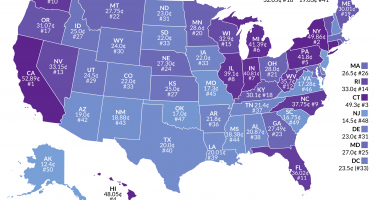The Dirty Secrecy of Clean Energy Costs
By DAVE ROBERTS
“Sunshine is the best disinfectant,” said Supreme Court Justice Lewis Brandeis regarding the need for governmental transparency – but apparently not when it comes to solar power and other renewable energy sources. California has embarked on an ambitious, unprecedented program to provide one-third of its power from renewable energy sources by 2020. It’s likely to be expensive replacing oil and cheap natural gas with costly, inefficient solar and wind power. But Californians aren’t being told how much extra they’ll have to pay.
“I don’t understand what the size of the bill will be for it all,” said Robert Michaels, a Cal State Fullerton professor of economics and an energy expert. “Basically, what’s happening is everybody is being kept in the dark about this. Allegedly because it’s necessary to maintain competition among projects. It’s a drama that none of us is allowed to see, and none of us is allowed to get the figures on.”
Many of the purchase power agreements for renewable energy projects are coming in at above the market rate for energy — a cost that will be passed on to ratepayers. But the amount is known only to the California Public Utilities Commission, which keeps the figures under wraps for years.
The CPUC approves nearly every renewable project that comes before it, regardless of cost. But that’s not how it was supposed to be. The enabling legislation in 2002 for what is known as the Renewables Portfolio Standard, SB 1078, required that the cost of proposed renewable projects be compared to the market price of energy, and that procurement be restricted if the project’s price is too high. It also provided for above-market costs to be paid from a state-controlled above-market fund, rather than passing the extra cost on to the consumer.
This was reaffirmed in follow-up legislation. In 2006, SB 107, by State Senator Joe Simitian, D-Palo Alto, increased and accelerated the renewable target goals while continuing to limit procurement if prices were too high. Likewise in 2007 with SB 1036 by then-Sen. Don Perata, D-Oakland. And similarly in last year’s SBx1 2 by Simitian.
But as the pressure has increased to meet the state’s renewable energy goals, the prices have also increased — and cost-containment has gone by the wayside like a golden eagle after flying into a windmill blade.
The average bids for solar projects doubled while wind projects increased about 50 percent from 2005 to 2007, according to the CPUC’s Division of Ratepayer Advocates in a report last August titled “The Green Rush.” Fifty-nine percent of renewable contracts have been awarded at above-the-market rates in recent years, with PG&E leading the way with 77 percent of its contracts.
But what about that above-market fund that was supposed to pick up the tab for the high-cost contracts? As of last August, $773 million had been allocated — but a whopping $6 billion is needed to pay for all of the above-market contracts that have been approved. Michaels said that fund has since run out of money.
Pay for It
“Essentially you now have no choice but to pay whatever the contract price is for the renewable,” he said. “Renewable energy in California means wind and solar. Wind is expensive and solar is astronomical, particularly for the power you get. So what you have got now is a more interesting problem: People are not allowed to find out what the actual bills for these projects will be. The reason is because the PUC has agreed with utilities complaining, ‘We can’t let ordinary people know what the price of these things are, because you can cause competitive problems and it can result in price fixing’ — or something like that.”
Michaels cited what he called an “outrageous project” — PG&E’s solar project in the Mojave Desert. The plant could cost an estimated $1.6 billion while generating only 250 megawatts. Although scheduled to be completed it 2014, it may not be hooked up to the electrical grid until 2018 after needed upgrades are made.
Likely emboldening PG&E to lay out that kind of money for a questionable project is that it comes with a $1.2 billion loan guarantee from the U.S. Department of Energy. That’s the same DOE that provided a $535 million loan guarantee for Solyndra.
“That’s a staggering amount to pay for the kind of power you are getting — it only works when the sun is shining,” said Michaels. “The Division of Ratepayer Advocates is very upset about all of this. But there’s nothing that can be done about it. This is only the start. When we get closer to the 33 percent requirement, it’s just going to get worse, because the resources will be even more expensive.”
Shortly after the PUC approved PGE’s 25-year contract for the Mojave project in November 2011, the Division of Ratepayer Advocates sent out a press release headlined, “DRA Troubled By Continued CPUC Approval of Overpriced Renewable Projects.” It pointed out that the CPUC had also recently approved the overpriced North Star Solar project in Fresno. Both approvals ignored the legislative directive to contain costs.
“The Commission has the power to keep the cost of renewable energy reasonable,” said DRA’s acting Director, Joe Como. “Instead … it is signaling to the market that California will accept overpriced renewable energy, and that it is willing to lock customers into higher rates for decades to come. I agree with Commissioner [Mike] Florio [the only vote against the Mojave project], who said that we should be getting twice the amount of renewable energy for the price of this contract.
“The CPUC must get serious about reducing greenhouse gas emissions from power plants, and it can’t do that by ignoring the costs. DRA strongly supports the state’s renewable energy goals, but fears that customer backlash against high energy bills will hurt the state’s efforts. Sending a message to renewable energy developers and investors that the cost of renewables must be reasonable will support the effort to reach California’s goals to reduce greenhouse gas. We simply can’t afford to do otherwise.”
Encouraging Development
One of the encouraging developments in renewable energy recently is the significant price drop for photovoltaic energy due to the increased production of solar cells (ironically a contributing factor in Solyndra’s demise because its products were made at a higher price). The cost of these systems dropped 19-23 percent in California (depending on the size of the system) from late 2008 to mid-2010. But, at the same time the utility bid prices for photovoltaic systems actually increased, according to the DRA.
Also concerned about the increased cost of renewable energy is the state watchdog agency the Little Hoover Commission. It held a hearing Feb. 28 at which Commissioner David Schwarz asked what can be done to get the CPUC to put the brakes on the renewable energy “spending binge.”
Matt Freedman, an attorney for The Utility Reform Network, responded, “The era of approving overpriced renewable generators has passed. Most were in 2008, 2009. For years the PUC has pretty much approved whatever the utilities wanted. It goes to the oversight of utilities by regulators who feel it’s their job to give the utilities what they want when they want it. There’s been a spending binge.”
But that binge may not be over, according to Como, who said, “The commission has accepted all but two contracts in the last several years. There have been about 170 contracts from 2003, and only two have been rejected. It does speak a lot to the fact that there are political and other pressures that go into the final decision other than ‘best fit, least cost’ analysis. I think we are still looking at contracts that are overpriced. The prices are confidential. But we do look at the trends.”
Schwarz accused Como’s group of not sufficiently advocating for ratepayers by not fighting the confidential pricing system. “Aren’t you doing your constituents a disservice?” Schwarz asked. “I would like to see confidentiality lifted so we have transparency.”
Como responded, “I’m in support of modifying confidentiality, not lifting it. Three years of confidentiality may be too long. Six months to a year would be good. Nevada doesn’t have a confidentiality cloak on its procurement.”
Asked what the cost impact will be to customers in order to achieve the 33 percent goal, Como said, “It’s probably about 5 to 7 percent on a typical bill of a customer. The above-market costs that we have identified, that’s probably what the impact will be.”
Cost Unknown
But Freedman said that no one knows how much it’s going to cost. In 2009, a consultant estimated there would be a 7 percent increase, but that study is already out of date because “all of the assumptions are totally wrong in respect to price. For example, it was thought solar thermal, big mirrors in the desert, was going to be the primary way we would reach the 33 percent target. It assumed 7,200 megawatts of solar thermal. Half of that has been canceled. It assumed photovoltaics would cost between 29 and 47 cents a kilowatt-hour. We have been looking at prices in the 11-to-14 cent range approved last year. They are lower today than last year, and it looks like they will be going lower still. Every long-term model ends up being wrong. In the field of renewables, we have seen a very dynamic market with extremely fast-changing prices, more than anybody could ever predict.”
The energy experts are confident that California will be able to meet the renewable energy goal by 2020. The big question remains the size of the bill that Californians will get stuck with.
“It would be wonderful if we can make this work,” said a dubious state Sen. Mark Wyland, R-Carlsbad, who is also a Little Hoover commissioner. “To me right now the bottom line is what is the cost to the user. Particularly in a state where we have the second-highest unemployment in the country, where privately a very senior official in this government has said, ‘We all know the real rate of unemployment is closer to 17 percent,’ where the human cost is really, really, really difficult, and at the same time when we have some companies leaving. I just think at the end of the day we need to know: Can we deliver this in such a way that it doesn’t hurt jobs? We’ll see.”
Related Articles
Noted Lawyer Slammed in Judicial Gulag
JULY 5, 2011 By RICHARD TRAINOR When I met Richard Fine in the summer of 2001, he was riding high.
Sacramento hits the gas on driving taxes
Within a few years, California may choose to tax drivers by the mile. Taking up a controversial idea floated by the
Sacramento growth plan: more low-income housing
March 19, 2013 By Katy Grimes When the going gets tough, the tough go shopping. But not in downtown Sacramento.




